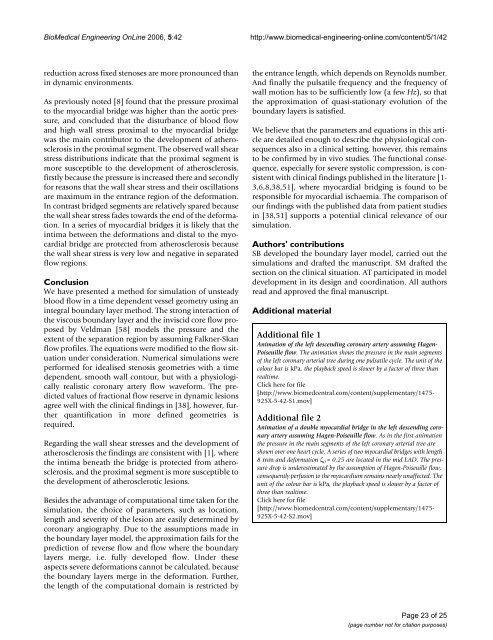Transient integral boundary layer method to calculate the ...
Transient integral boundary layer method to calculate the ...
Transient integral boundary layer method to calculate the ...
Create successful ePaper yourself
Turn your PDF publications into a flip-book with our unique Google optimized e-Paper software.
BioMedical Engineering OnLine 2006, 5:42http://www.biomedical-engineering-online.com/content/5/1/42reduction across fixed stenoses are more pronounced thanin dynamic environments.As previously noted [8] found that <strong>the</strong> pressure proximal<strong>to</strong> <strong>the</strong> myocardial bridge was higher than <strong>the</strong> aortic pressure,and concluded that <strong>the</strong> disturbance of blood flowand high wall stress proximal <strong>to</strong> <strong>the</strong> myocardial bridgewas <strong>the</strong> main contribu<strong>to</strong>r <strong>to</strong> <strong>the</strong> development of a<strong>the</strong>rosclerosisin <strong>the</strong> proximal segment. The observed wall shearstress distributions indicate that <strong>the</strong> proximal segment ismore susceptible <strong>to</strong> <strong>the</strong> development of a<strong>the</strong>rosclerosis,firstly because <strong>the</strong> pressure is increased <strong>the</strong>re and secondlyfor reasons that <strong>the</strong> wall shear stress and <strong>the</strong>ir oscillationsare maximum in <strong>the</strong> entrance region of <strong>the</strong> deformation.In contrast bridged segments are relatively spared because<strong>the</strong> wall shear stress fades <strong>to</strong>wards <strong>the</strong> end of <strong>the</strong> deformation.In a series of myocardial bridges it is likely that <strong>the</strong>intima between <strong>the</strong> deformations and distal <strong>to</strong> <strong>the</strong> myocardialbridge are protected from a<strong>the</strong>rosclerosis because<strong>the</strong> wall shear stress is very low and negative in separatedflow regions.ConclusionWe have presented a <strong>method</strong> for simulation of unsteadyblood flow in a time dependent vessel geometry using an<strong>integral</strong> <strong>boundary</strong> <strong>layer</strong> <strong>method</strong>. The strong interaction of<strong>the</strong> viscous <strong>boundary</strong> <strong>layer</strong> and <strong>the</strong> inviscid core flow proposedby Veldman [58] models <strong>the</strong> pressure and <strong>the</strong>extent of <strong>the</strong> separation region by assuming Falkner-Skanflow profiles. The equations were modified <strong>to</strong> <strong>the</strong> flow situationunder consideration. Numerical simulations wereperformed for idealised stenosis geometries with a timedependent, smooth wall con<strong>to</strong>ur, but with a physiologicallyrealistic coronary artery flow waveform. The predictedvalues of fractional flow reserve in dynamic lesionsagree well with <strong>the</strong> clinical findings in [38], however, fur<strong>the</strong>rquantification in more defined geometries isrequired.Regarding <strong>the</strong> wall shear stresses and <strong>the</strong> development ofa<strong>the</strong>rosclerosis <strong>the</strong> findings are consistent with [1], where<strong>the</strong> intima beneath <strong>the</strong> bridge is protected from a<strong>the</strong>rosclerosis,and <strong>the</strong> proximal segment is more susceptible <strong>to</strong><strong>the</strong> development of a<strong>the</strong>rosclerotic lesions.Besides <strong>the</strong> advantage of computational time taken for <strong>the</strong>simulation, <strong>the</strong> choice of parameters, such as location,length and severity of <strong>the</strong> lesion are easily determined bycoronary angiography. Due <strong>to</strong> <strong>the</strong> assumptions made in<strong>the</strong> <strong>boundary</strong> <strong>layer</strong> model, <strong>the</strong> approximation fails for <strong>the</strong>prediction of reverse flow and flow where <strong>the</strong> <strong>boundary</strong><strong>layer</strong>s merge, i.e. fully developed flow. Under <strong>the</strong>seaspects severe deformations cannot be <strong>calculate</strong>d, because<strong>the</strong> <strong>boundary</strong> <strong>layer</strong>s merge in <strong>the</strong> deformation. Fur<strong>the</strong>r,<strong>the</strong> length of <strong>the</strong> computational domain is restricted by<strong>the</strong> entrance length, which depends on Reynolds number.And finally <strong>the</strong> pulsatile frequency and <strong>the</strong> frequency ofwall motion has <strong>to</strong> be sufficiently low (a few Hz), so that<strong>the</strong> approximation of quasi-stationary evolution of <strong>the</strong><strong>boundary</strong> <strong>layer</strong>s is satisfied.We believe that <strong>the</strong> parameters and equations in this articleare detailed enough <strong>to</strong> describe <strong>the</strong> physiological consequencesalso in a clinical setting, however, this remains<strong>to</strong> be confirmed by in vivo studies. The functional consequence,especially for severe sys<strong>to</strong>lic compression, is consistentwith clinical findings published in <strong>the</strong> literature [1-3,6,8,38,51], where myocardial bridging is found <strong>to</strong> beresponsible for myocardial ischaemia. The comparison ofour findings with <strong>the</strong> published data from patient studiesin [38,51] supports a potential clinical relevance of oursimulation.Authors' contributionsSB developed <strong>the</strong> <strong>boundary</strong> <strong>layer</strong> model, carried out <strong>the</strong>simulations and drafted <strong>the</strong> manuscript. SM drafted <strong>the</strong>section on <strong>the</strong> clinical situation. AT participated in modeldevelopment in its design and coordination. All authorsread and approved <strong>the</strong> final manuscript.Additional materialAdditional file 1Animation of <strong>the</strong> left descending coronary artery assuming Hagen-Poiseuille flow. The animation shows <strong>the</strong> pressure in <strong>the</strong> main segmentsof <strong>the</strong> left coronary arterial tree during one pulsatile cycle. The unit of <strong>the</strong>colour bar is kPa, <strong>the</strong> playback speed is slower by a fac<strong>to</strong>r of three thanrealtime.Click here for file[http://www.biomedcentral.com/content/supplementary/1475-925X-5-42-S1.mov]Additional file 2Animation of a double myocardial bridge in <strong>the</strong> left descending coronaryartery assuming Hagen-Poiseuille flow. As in <strong>the</strong> first animation<strong>the</strong> pressure in <strong>the</strong> main segments of <strong>the</strong> left coronary arterial tree areshown over one heart cycle. A series of two myocardial bridges with length8 mm and deformation ζ 0 = 0.25 are located in <strong>the</strong> mid LAD. The pressuredrop is underestimated by <strong>the</strong> assumption of Hagen-Poiseuille flow,consequently perfusion <strong>to</strong> <strong>the</strong> myocardium remains nearly unaffected. Theunit of <strong>the</strong> colour bar is kPa, <strong>the</strong> playback speed is slower by a fac<strong>to</strong>r ofthree than realtime.Click here for file[http://www.biomedcentral.com/content/supplementary/1475-925X-5-42-S2.mov]Page 23 of 25(page number not for citation purposes)









